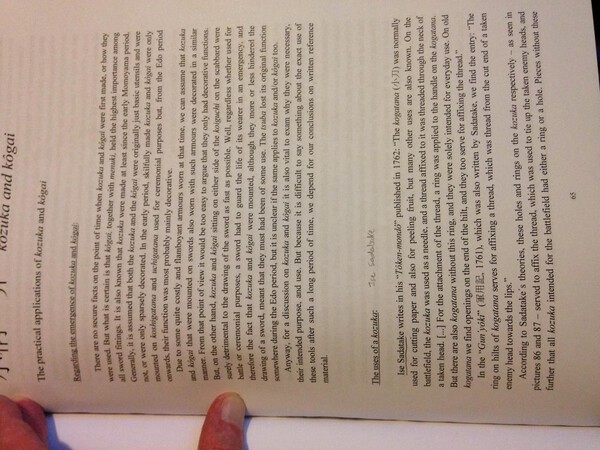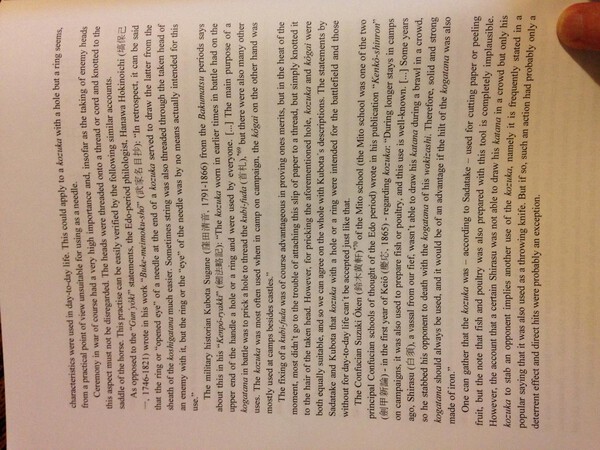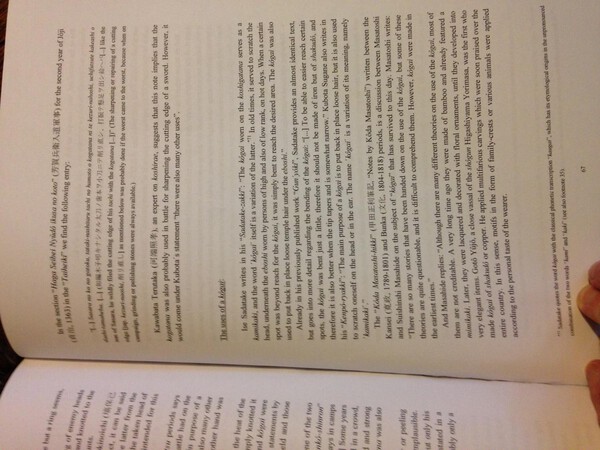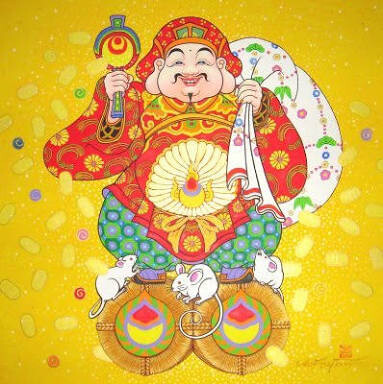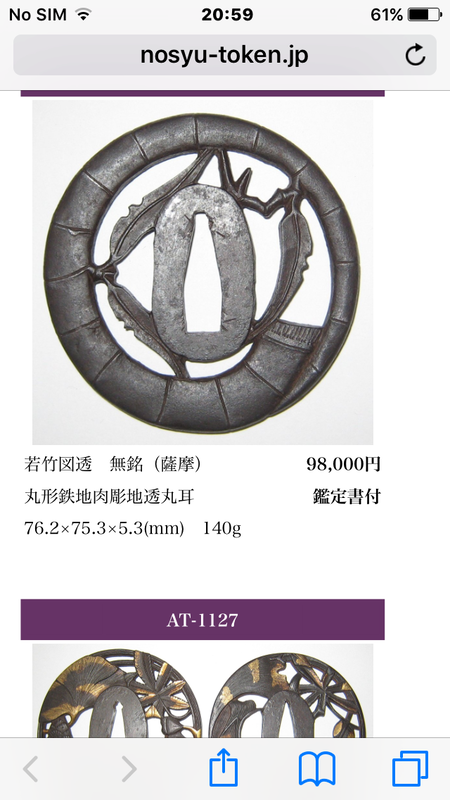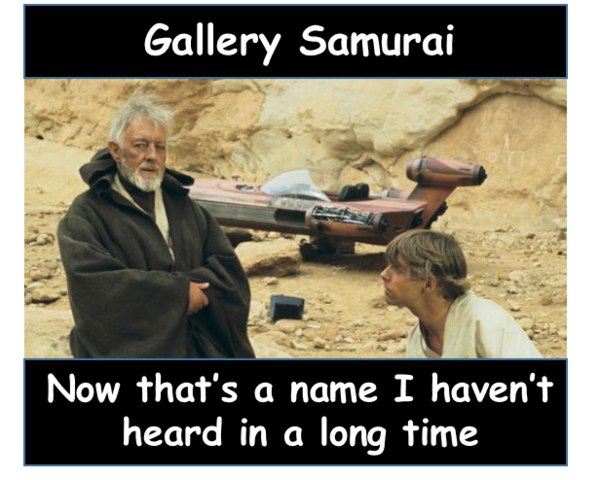-
Posts
1,813 -
Joined
-
Last visited
-
Days Won
8
Everything posted by Henry Wilson
-
I would say more Katchushi plate rather than tosho. The fineness of the plate surface and the sukashi make me think so. It could be a damaged tsuba resurrected with a new rim. It is a mish-mash of styles so Shoami is the grab bag group for such things in my opinion.
-
Is it for moving charcoal around in the fire for tea ceremony?
-
-
Rats are one of the animals of the Chinese zodiac. However, the tsuba has a few of them frolicking about. I think for this tsuba they are generally an Edo period thing and back then auspiciously associated with abundance. The tsuba theme in my opinion is suggestive of Daikoku (the brother of Ebisu) and his rats are associated with his rice bales he stands on, hence the implication of prosperity, wealth and security. I can also second Fords skill of restoring tsuba. He has done some magic on a few of my hopeless cases which I tend to gather.
-
"How do you tell ivory piano keys from plastic ones?" Use a red hot needle.
-
I personally find Masamune blades to be the hardest but the most rewarding to study. From the few that I have seen through museum glass I have always felt in comparison to other highly acclaimed swords that they are a lot less flamboyant and more restrained, making them more interesting. You have to look carefully and spend time with the sword as it it reveals itself. That is why I asked about oshigata as I am pretty sure that I could see a large yuzuha (dovetail/crest moon shape) about a third of the way down from the point and guessed that an oshigata would reveal a bit more. It seems that the person who did the double sided large oshigata on the blog did not see it though and wonder what I actually saw. This leads to the more interesting question of how did three quite different draughts of the sword get produced. As I say, Masamune leaves you wanting to have another look. I enjoyed comparing that sword to the Muramasa and the one thing that they have in common was that the details were quite hard to see. Overall, the exhibition was very interesting. I hadn't been in the sword museum for a long time and was surprised that it was so busy for a Friday afternoon. There were a lot of twenty-something girls (anime type I think) and tourists, which is a big change from the usual clientele of middle-aged to old guys. Another highlight for me was the Compton Ichimomji. A beautiful shape (like a fish bone, if I dare say) and surface features that are outstanding and very vivid.
-
I am very sorry to hear such sad news. His input will be missed. Rest in peace.
-
Can anyone direct me to a photo and/or oshigata of the "Musashi Masamune" sword as displayed in the Japanese Sword Museum Final Exhibition in Yoyogi. Many thanks in advance.
-
Thank you all for the discussion. You have put my mind at ease. The sword in question is koto from the late Muromachi. Yes, I remember that sword well Guido. Nice it went juyo. To sum up, muneware aren't so bad, especially on a koto sword.
-
Thank you all for your replies and thoughts. The sword has NBTHK papers so either the team did not notice the muneware or they felt it does not detract from the blade which has quite a coarse itame hada anyway. I have tried (and failed) to take pictures but to be honest there is nothing really to show. There are actually two muneware, one that seems to be very minor and the one I noticed yesteday that seems to correspond with an ever so slight swelling on the mune side of sword suggesting an opening or bubble. Nothing (except for the ware) is noticeable to the eye and the swelling can only be felt when running a cloth over it. Like I said I thought it was the result of a divet from a dodgy polish. Evidently not. The connoissuers book says muneware is an example of the smiths "lack of skill". That made me smile! Nowhere have I read that it is a fatal flaw. I am wondering what to do. I am very fond of the sword but it might be time to have it polished. Could the ware be polished in? Or something else... Anymore thoughts from members would be gratefully appreciated.
-
Thanks Geraint I am thinking that it is a split along the blade's mune not just a surface opening. What brought my attention to it was when I cleaned the blade with a cloth there was a sort of drag as I brought the cloth along the blade. I thought it was a result of a bad polish but the muneware makes me think otherwise. Would it be grounds for a refund from the seller? It was not disclosed in the sales info and when I went to see the blade.
-
Does anyone know the Japanese for an opening that runs along the mune? I have a sword that I bought last October with NBTHK papers and it appears to have such an opening.
-
Excellent. What everyone says above plus the whiskers are so finely done. They look real. Do you have more pictures of the reverse side? Are there mountains on the left?
-
-
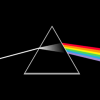
Anyone Knows This Gentleman?
Henry Wilson replied to Marius's topic in Auctions and Online Sales or Sellers
From the links above, he used to run.... As a newbie then, it was a bit like an Aladdin's cave at the end of the Omotesando in Harajuku. It is now long gone. I went in once and thought I found the bargain of a lifetime, a polished wakizashi in new shirasaya for 50万円... which I read as 50,000 yen. I came back with five crisp notes and a smile on my face... How wrong I was. I tried to buy his Fujishiro's instead. Which also failed. His staff did point me to an excellent sword bookstore on Yasukuni dori though. Ah the good old days. -

F.s.- A Very Nice Iron Tsuba-Probably Echizen School
Henry Wilson replied to christianmalterre's topic in For Sale or Trade
PM sent -

General Development Collecting Nihonto/tosogu
Henry Wilson replied to BIG's topic in General Nihonto Related Discussion
Alan wrote: "Now that's just silly! Almost as silly as my previous post. Perhaps it was meant to be tongue in cheek." Silly is what silly does. Half tongue in check because I knew there would be heat but... Alan wrote: "What if someone buys a sword and sends it in for polish? Then he submits it to shinsa and it passes to a higher level. Expenses are incurred. Should he then sell it for 5% less than he originally paid for it?" Yes, why not? Especially if you are not a dealer. It is what I do. I rarely sell for what I pay and never (to my memory) sold above what I paid. I just can't do it. I feel embarrassed. I am sure most of us hobbyists could live with a slight reduction in return. Call it rental fees and respect for the item in question to make the hobby less cut throat. I remember I bought something from a respected collector. In a general summary to conceal IDs she basically said that she does not believe in ripping off people like me so she will sell for what she paid. However, she said she will charge a slight fee to soften the load of not having access to the money that was tied up in the item I eventually bought. I found that quite distasteful. Is it an investment or an appreciation of art? Alan wrote "The market ultimately determines what a piece is worth. It is the same in the art world. The market goes up and down, and some artists pieces become more or less desirable as their relative desirability and the trends dictate. Quality of the piece and the reputation of the artist also come into consideration." In my opinion, what people are willing to pay determines worth. But I guess that is not the point, eh? Alan wrote "Are you a true collector" I think I am. I try not to turn a few financial tricks. I don't need to or want to. I find it very crass. -

General Development Collecting Nihonto/tosogu
Henry Wilson replied to BIG's topic in General Nihonto Related Discussion
Why don't we all agree to price any items for sale at 5 % below what we paid for them? In that way, slowly but surely, prices will come down... -

Attention Namban Collectors ....
Henry Wilson replied to nagamaki - Franco's topic in Auctions and Online Sales or Sellers
Lol. Not a red tsuba but a very subtle black to blue hue. The motif is apparently a "Portuguese cross". Nobuie tsuba by the way folks!!! -

Attention Namban Collectors ....
Henry Wilson replied to nagamaki - Franco's topic in Auctions and Online Sales or Sellers
While we are tangenting to Christian themes, I saw this bad boy today in the Tokyo National museum. The pic is from the Ito book translated by Markus. It is described as 花クルス "flower cross" and was very nice to see. A very thick and powerful piece. -
The triangular arms on each side are probably so that the menuki can be wrapped under the tsuka thread with out covering the design that is meant to be seen IMO.



